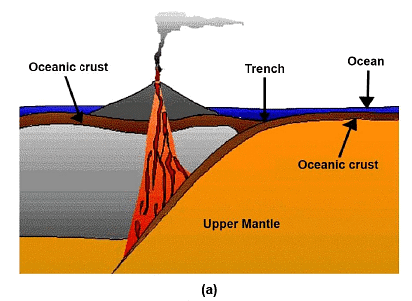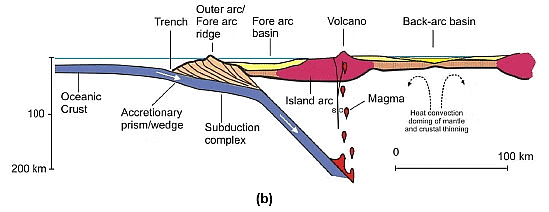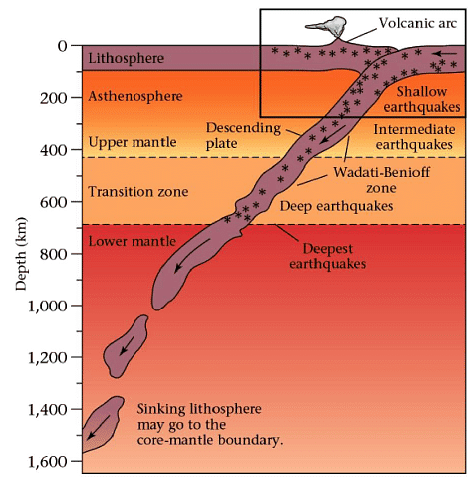UPSC Exam > UPSC Notes > Geology Optional for UPSC > Island Arcs, Trenches
Island Arcs, Trenches | Geology Optional for UPSC PDF Download
| Table of contents |

|
| Island arcs, trenches, and mid-ocean ridges |

|
| Island Arcs |

|
| Volcanic Arcs |

|
| Trenches |

|
| Marginal Basins |

|
| Benioff Zone or Wadati-Benioff Zone |

|
Island arcs, trenches, and mid-ocean ridges
Island arcs, trenches, and mid-ocean ridges are all key features associated with plate tectonics and the movements of Earth's lithospheric plates. Here's a breakdown of each:
Volcanic arcs: a) Volcanic island arc

b) Continental volcanic arc.

Island Arcs
- Island arcs are long chains or belts of volcanic islands or seamounts that form parallel to and usually at some distance from the boundary where two lithospheric plates converge.
- They are typically found in oceanic regions and are associated with subduction zones, where one tectonic plate is forced beneath another into the mantle.
- The volcanic activity in island arcs is primarily due to the melting of the descending plate and the subsequent rise of magma to the surface.
- Island arcs are characterized by strong seismic activity and volcanic eruptions.
- Examples include the Aleutian Islands, the Japanese Archipelago, and the Lesser Antilles.
Question for Island Arcs, TrenchesTry yourself: Which of the following is a characteristic feature of island arcs?View Solution
- Island arcs.

Trenches:
- Trenches are deep, elongated depressions on the ocean floor that occur at subduction zones, where one tectonic plate is being forced beneath another.
- They are the deepest parts of the ocean and are often associated with intense seismic activity.
- Trenches mark the locations where one lithospheric plate is being subducted beneath another into the Earth's mantle.
- The Marianas Trench in the western Pacific Ocean is the deepest known trench on Earth.
Mid-Ocean Ridges:
- Mid-ocean ridges are underwater mountain ranges that run along the ocean floor and represent divergent boundaries where two tectonic plates are moving apart.
- These ridges are characterized by intense volcanic and seismic activity.
- As the plates move apart, magma from the mantle rises to fill the gap, solidifies, and forms new oceanic crust.
- The Mid-Atlantic Ridge is one of the most well-known mid-ocean ridges, running through the Atlantic Ocean from north to south.
- These geological features are fundamental to our understanding of plate tectonics and the dynamic processes that shape the Earth's surface. They play significant roles in the distribution of earthquakes, volcanic activity, and the formation of new crust on our planet.
Volcanic Arcs
Formation Process:
When a tectonic plate is subducted beneath another plate, it descends into the mantle, reaching depths of about 100 km (60 miles). At this depth, the subducted plate becomes hot enough to release its volatile components, initiating partial melting of the mantle above it, known as the mantle wedge. This melting produces basaltic magma, which rises to the surface, giving birth to a line of volcanoes known as a volcanic arc.Location:
Volcanic arcs are typically situated a few hundred kilometers behind oceanic trenches, parallel to the boundary between the subducting and overriding plates.Fore-Arc Basins:
Between the trench and the volcanic arc lies the fore-arc region, which includes an accretionary wedge formed by sediment deposition and a fore-arc basin. The fore-arc region is prone to significant thrust earthquakes due to tectonic stresses from the movement of plates.
Trenches
Formation:
Trenches form on the subducting side of island arcs as a result of the gravitational pull of the dense subducting plate on the leading edge of the overriding plate. They are the deepest features of ocean basins, with depths reaching several kilometers. Earthquakes frequently occur along subduction boundaries, defining the Benioff zone.Examples:
Notable trenches include the Mariana Trench, one of the deepest in the world, and the Andaman Trench in the Indian Ocean.
Marginal Basins
Location and Formation:
Marginal basins develop between continental margins and island arcs on the concave side of the arc. They have either oceanic or intermediate crust and are characterized by significant hydrothermal activity. These basins form as a result of tensional tectonics due to the rifting of an existing island arc.Characteristics:
Marginal basins are typically long and narrow, stretching hundreds to thousands of kilometers. They are bounded by back-arc ridges and are found along the western margin of the Pacific Ocean, near the convergence of tectonic plates.Examples:
Examples of marginal basins include the Sea of Japan, the Mariana Trough in the Philippine Sea, and the South Fiji Basin.
Question for Island Arcs, TrenchesTry yourself: What is the process involved in the formation of volcanic arcs?View Solution
Benioff Zone or Wadati-Benioff Zone
Definition:
The Benioff zone, also known as the Wadati-Benioff zone, is a planar zone that dips under the overriding plate, characterized by intense seismic and volcanic activity. It extends from near the surface to depths of about 700 km below the Earth's surface.Formation:
This zone is defined by the location of seismic events below volcanic island arcs and continental margins above active subduction zones. It can result from slip along the subduction thrust fault or slip on faults within the descending plate.
 Benioff zone or Wadatti-Benioff zone
Benioff zone or Wadatti-Benioff zone
The document Island Arcs, Trenches | Geology Optional for UPSC is a part of the UPSC Course Geology Optional for UPSC.
All you need of UPSC at this link: UPSC
|
64 videos|135 docs
|
FAQs on Island Arcs, Trenches - Geology Optional for UPSC
| 1. What are island arcs and how are they formed? |  |
Ans. Island arcs are curved chains of islands that form parallel to the boundary where two tectonic plates converge. They are typically formed by the subduction of one oceanic plate beneath another, leading to volcanic activity and the creation of islands.
| 2. What is the significance of trenches in plate tectonics? |  |
Ans. Trenches are deep underwater depressions that form at subduction zones where one tectonic plate is being forced beneath another. Trenches play a crucial role in the process of plate tectonics by allowing for the recycling of old oceanic crust back into the mantle.
| 3. How do mid-ocean ridges contribute to the formation of new oceanic crust? |  |
Ans. Mid-ocean ridges are underwater mountain ranges where tectonic plates are moving apart, allowing magma to rise up from the mantle and solidify into new oceanic crust. This process, known as seafloor spreading, helps to expand the size of the ocean basins.
| 4. What are marginal basins and how do they form? |  |
Ans. Marginal basins are elongated, shallow basins located at the edges of continents or island arcs. They are often formed as a result of tectonic processes such as rifting or the back-arc spreading that occurs behind island arcs.
| 5. What is the significance of the Benioff Zone or Wadati-Benioff Zone in the context of island arcs and trenches? |  |
Ans. The Benioff Zone, also known as the Wadati-Benioff Zone, is a seismically active region that is inclined beneath a volcanic arc or island arc. It represents the subduction of one tectonic plate beneath another and is associated with the occurrence of deep-focus earthquakes.
Related Searches















